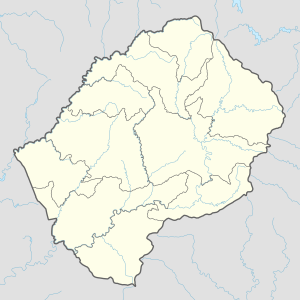Hlotse | |
|---|---|
 Downtown Hlotse | |
| Coordinates: 28°52′24.1″S 28°02′29.7″E / 28.873361°S 28.041583°E | |
| Country | |
| District | Leribe District |
| Constituency | Hlotse |
| Population (2016) | |
| • Total | 38,558 |
| Time zone | UTC+2 (SAST) |
Hlotse (also Leribe) is an important market town in Lesotho. It is situated on the Hlotse River, near the South African border. The town was founded in 1876 by a British missionary, Reverend John Widdicombe. It was a colonial centre until Lesotho gained its independence. The population in 2016 was 38,558.[1]
The alternate name, Leribe, comes from the adjacent French Protestant Leribe Mission, founded in 1859 by François Coillard. Hlotse is also called Leribe because it is the camptown in the district of Leribe.
The main Basotho Headquarters for Help Lesotho is in Hlotse.
Places of interest[edit]

Three different sightseeing locations are the Leribe Craft Centre, statue in front of the District Administration office, and an old military lookout.
The Leribe Craft Centre sells handmade wool items ranging from scarfs to jackets. The craft centre is located on the side of the road as a person comes into Hlotse. The statue in front of the District Administration building dates back to English rule of Lesotho. It is located in the central part of the city. The old military lookout also dates back to English rule and is located in the central part of the city.
References[edit]
External links[edit]
 Hlotse travel guide from Wikivoyage
Hlotse travel guide from Wikivoyage

Well, that’s interesting to know that Psilotum nudum are known as whisk ferns. Psilotum nudum is the commoner species of the two. While the P. flaccidum is a rare species and is found in the tropical islands. Both the species are usually epiphytic in habit and grow upon tree ferns. These species may also be terrestrial and grow in humus or in the crevices of the rocks.
View the detailed Guide of Psilotum nudum: Detailed Study Of Psilotum Nudum (Whisk Fern), Classification, Anatomy, Reproduction